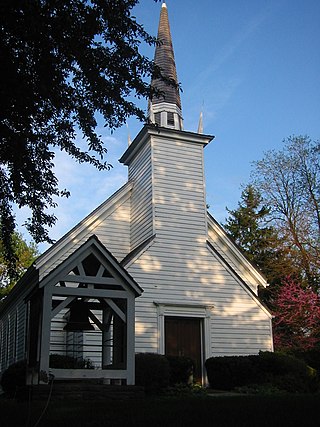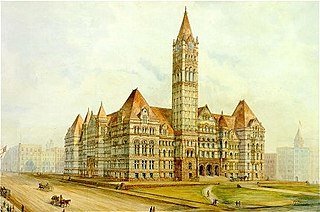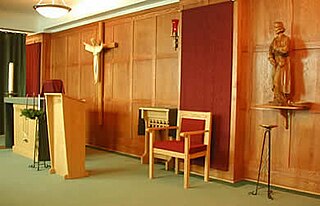
Oronhyatekha, , was a Mohawk physician, scholar, and a unique figure in the history of British colonialism. He was the first known aboriginal scholar at Oxford University; a successful CEO of a multinational financial institution; a native statesman; an athlete of international standing; and an outspoken champion of the rights of women, children, and minorities. He was once thought to be the first Native M.D. in Canada, having gotten his degree in 1866 from Toronto School of Medicine, but Peter Edmund Jones (Ojibwa), from New Credit, has been documented as having graduated a few months before Oronhyatekha. The fact that Oronhyatekha achieved these results during the Victorian era, when racism and pressure for First Nations peoples to assimilate were commonplace, has made him a figure approaching legend in some aboriginal circles.

Hastings County is located in the province of Ontario, Canada. Geographically, it is located on the border of Eastern Ontario and Central Ontario. Hastings County is the second-largest county in Ontario, after Renfrew County, and its county seat is Belleville, which is independent of Hastings County. Hastings County has trademarked the moniker "Cheese Capital of Canada".

Adolphustown is a geographic area located in Greater Napanee, Ontario, Canada, on the Adolphus Reach of the Bay of Quinte in Lake Ontario. Adolphustown is now part of the town of Greater Napanee. The rural character of the Adolphustown region remains largely undisturbed today and the area, with its picturesque lakefront location, remains popular for the cultivation of apples and strawberries.

Six Nations is demographically the largest First Nations reserve in Canada. As of the end of 2017, it has a total of 27,276 members, 12,848 of whom live on the reserve. These nations are the Mohawk, Cayuga, Onondaga, Oneida, Seneca and Tuscarora. Some Lenape live in the territory as well.

A chapel royal is an establishment in the British and Canadian royal households serving the spiritual needs of the sovereign and the royal family.

The Mohawks of the Bay of Quinte (MBQ) are a Mohawk community within Hastings County, Ontario. They control the Tyendinaga Mohawk Territory, which is a 7,362.5 ha (18,193-acre) Mohawk Indian reserve on the Bay of Quinte in southeastern Ontario, Canada, east of Belleville and immediately to the west of Deseronto. They also share Glebe Farm 40B and the Six Nations of the Grand River reserves with other First Nations.

His Majesty's Royal Chapel of the Mohawks in Brantford, Ontario is the oldest surviving church building in Ontario and was the first Anglican church in Upper Canada. It is one of only three Chapels Royal in Canada. In 1981, the chapel was designated a National Historic Site of Canada.
Tyendinaga (Mohawk) Airport is a registered aerodrome that is open to the public and caters mainly to general aviation. The aerodrome is located in Tyendinaga Mohawk Territory, 3 nautical miles southwest of Tyendinaga, Ontario, Canada, north of the Bay of Quinte between Kingston and Belleville.

The Four Indian Kings or Four Kings of the New World were three Mohawk chiefs from one of the Five Nations of the Iroquois Confederacy and a Mohican of the Algonquian peoples, whose portraits were painted by John Verelst in London to commemorate their travel from New York in 1710 to meet Queen Anne of Great Britain. The three Mohawk were: Sa Ga Yeath Qua Pieth Tow of the Bear Clan, called King of Maquas, with the Christian name Peter Brant ; Ho Nee Yeath Taw No Row of the Wolf Clan, called King of Canajoharie, or John of Canajoharie; and Tee Yee Ho Ga Row, meaning "Double Life", of the Wolf Clan, also called Hendrick Tejonihokarawa or King Hendrick. The Mohican chief was Etow Oh Koam of the Turtle Clan, mistakenly identified in his portrait as Emperor of the Six Nations. The Algonquian-speaking Mohican people were not part of the Iroquois Confederacy. Five chiefs set out on the journey, but one died in mid-Atlantic.

St Etheldreda's Church is a Catholic church in Ely Place, off Charterhouse Street in Holborn, London. The building is one of only two surviving in London from the reign of Edward I, and dates from between 1250 and 1290. It is dedicated to Æthelthryth, or Etheldreda, the Anglo-Saxon saint who founded the monastery at Ely in 673. It was the chapel of the London residence of the Bishops of Ely.

John Norton (Teyoninhokarawen) was a Mohawk chief, Indian Department interpreter and a school master. He was adopted by the Mohawk at about age 30 at their major reserve in Canada. After deserting the British military in the late 18th century, he became a military leader of Iroquois warriors in the War of 1812 on behalf of Great Britain against the United States. Commissioned as a major, he led warriors from the Six Nations of the Grand River into battle against American invaders at Queenston Heights, Stoney Creek, and Chippawa.

Deseronto is a town in the Canadian province of Ontario, in Hastings County, located at the mouth of the Napanee River on the shore of the Bay of Quinte, on the northern side of Lake Ontario.

The Toronto Purchase was the sale of lands in the Toronto area from the Mississaugas of New Credit to the British crown. An initial, disputed, agreement was made in 1787, in exchange for various items. The agreement was revisited in 1805, intended to clarify the area purchased. The agreement remained in dispute for over 200 years until 2010, when a settlement for the land was made between the Government of Canada and the Mississaugas for the land and other lands in the area.

By the arrangements of the Canadian federation, Canada's monarchy operates in Ontario as the core of the province's Westminster-style parliamentary democracy. As such, the Crown within Ontario's jurisdiction may be referred to as the Crown in Right of Ontario, His Majesty in Right of Ontario, the King in Right of Ontario, or His Majesty the King in Right of Ontario. The Constitution Act, 1867, leaves many functions in Ontario specifically assigned to the sovereign's viceroy, the lieutenant governor of Ontario, whose direct participation in governance is limited by the constitutional conventions of constitutional monarchy.
The association between the monarchy of Canada and Indigenous peoples in Canada stretches back to the first interactions between North American Indigenous peoples and European colonialists and, over centuries of interface, treaties were established concerning the monarch and Indigenous nations. First Nations, Inuit, and Métis peoples in Canada have a unique relationship with the reigning monarch and, like the Māori and the Treaty of Waitangi in New Zealand, generally view the affiliation as being not between them and the ever-changing Cabinet, but instead with the continuous Crown of Canada, as embodied in the reigning sovereign.

Alderville First Nation is a band of Mississaugas, a sub-nation of the Ojibways. The Alderville and Sugar Island 37A reserves belong to that First Nation band government.

In 2013, the Royal Military College of Canada is celebrating the 50th anniversary of the two small devotional chapels in Yeo Hall, which were installed in 1963. With a view to encourage and enhance their spiritual well-being, the Protestant and Royal Catholic Chaplains, cadets and staff use the Chapels. Gifts to the chapels have been made by successive generations of cadets and ex-cadets.

Tyendinaga Mohawk Territory is the main First Nation reserve of the Mohawks of the Bay of Quinte First Nation. The territory is located in Ontario east of Belleville on the Bay of Quinte. Tyendinaga is located near the site of the former Mohawk village of Ganneious.:10

Wallace Havelock Robb was a Canadian poet, naturalist, and philosopher known for his poetry and prose on Canadian life and Iroquois lore. He was the founder of Abbey Dawn – a bird sanctuary, museum, art gallery, and poet's retreat – located approximately five miles east of Kingston, Ontario.
The Chapel Royal at Massey College, also known as St. Catherine's Chapel, is the chapel of Massey College, a graduate residential college at the University of Toronto. Founded in 1963, it was made the third Chapel Royal in Canada by Queen Elizabeth II in 2017. It is the first ecumenical and interfaith worship space to be given the designation.
























